Expanding the clinical spectrum of hereditary fibrosing poikiloderma with tendon contractures, myopathy and pulmonary fibrosis due to FAM111B mutations
- PMID: 26471370
- PMCID: PMC4608180
- DOI: 10.1186/s13023-015-0352-4
Expanding the clinical spectrum of hereditary fibrosing poikiloderma with tendon contractures, myopathy and pulmonary fibrosis due to FAM111B mutations
Abstract
Background: Hereditary Fibrosing Poikiloderma (HFP) with tendon contractures, myopathy and pulmonary fibrosis (POIKTMP [MIM 615704]) is a very recently described entity of syndromic inherited poikiloderma. Previously by using whole exome sequencing in five families, we identified the causative gene, FAM111B (NM_198947.3), the function of which is still unknown. Our objective in this study was to better define the specific features of POIKTMP through a larger series of patients.
Methods: Clinical and molecular data of two families and eight independent sporadic cases, including six new cases, were collected.
Results: Key features consist of: (i) early-onset poikiloderma, hypotrichosis and hypohidrosis; (ii) multiple contractures, in particular triceps surae muscle contractures; (iii) diffuse progressive muscular weakness; (iv) pulmonary fibrosis in adulthood and (v) other features including exocrine pancreatic insufficiency, liver impairment and growth retardation. Muscle magnetic resonance imaging was informative and showed muscle atrophy and fatty infiltration. Histological examination of skeletal muscle revealed extensive fibroadipose tissue infiltration. Microscopy of the skin showed a scleroderma-like aspect with fibrosis and alterations of the elastic network. FAM111B gene analysis identified five different missense variants (two recurrent mutations were found respectively in three and four independent families). All the mutations were predicted to localize in the trypsin-like cysteine/serine peptidase domain of the protein. We suggest gain-of-function or dominant-negative mutations resulting in FAM111B enzymatic activity changes.
Conclusions: HFP with tendon contractures, myopathy and pulmonary fibrosis, is a multisystemic disorder due to autosomal dominant FAM111B mutations. Future functional studies will help in understanding the specific pathological process of this fibrosing disorder.
Figures
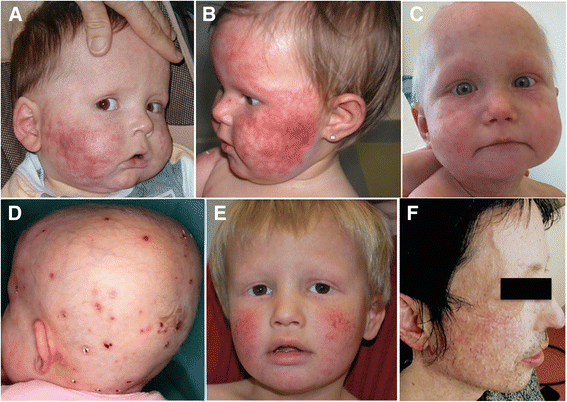
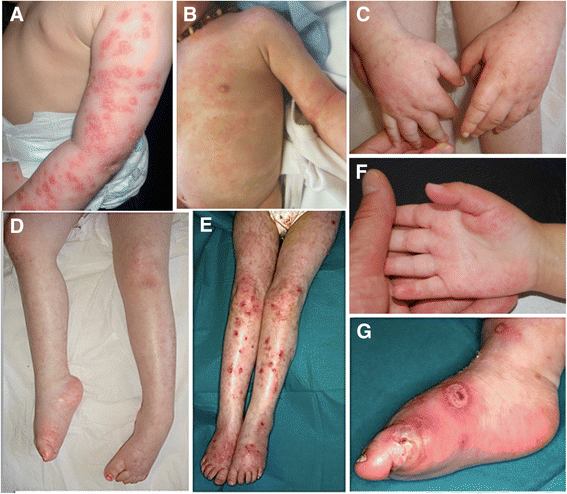
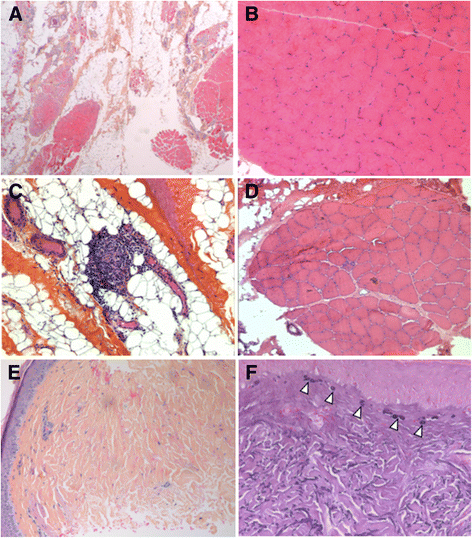
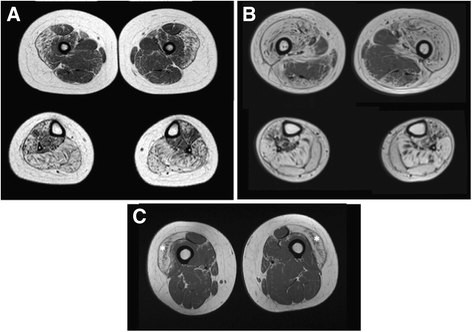
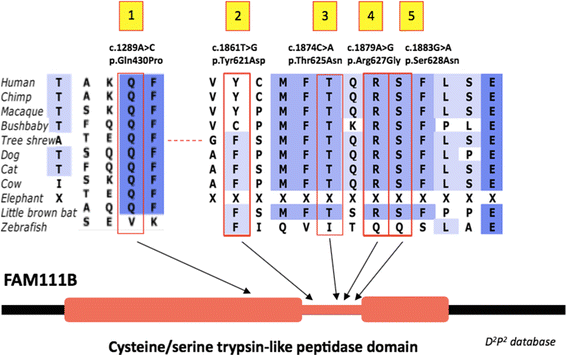
Similar articles
-
Family of hereditary fibrosing poikiloderma with tendon contractures, myopathy and pulmonary fibrosis caused by a novel FAM111B mutation.J Dermatol. 2019 Nov;46(11):1014-1018. doi: 10.1111/1346-8138.15045. Epub 2019 Aug 7. J Dermatol. 2019. PMID: 31392773
-
[Pulmonary fibrosis associated with hereditary fibrosing poikiloderma caused by FAM111B mutation: A case report].Rev Mal Respir. 2018 Nov;35(9):968-973. doi: 10.1016/j.rmr.2018.09.002. Epub 2018 Oct 16. Rev Mal Respir. 2018. PMID: 30341002 French.
-
Dermatological manifestations of hereditary fibrosing poikiloderma with tendon contractures, myopathy and pulmonary fibrosis (POIKTMP): a case series of 28 patients.Br J Dermatol. 2019 Oct;181(4):862-864. doi: 10.1111/bjd.17996. Epub 2019 Apr 10. Br J Dermatol. 2019. PMID: 30972747 No abstract available.
-
Hereditary fibrosing poikiloderma (POIKTMP syndrome) report of a new mutation and review of the literature.Pediatr Dermatol. 2023 Jan;40(1):182-187. doi: 10.1111/pde.15133. Epub 2022 Sep 14. Pediatr Dermatol. 2023. PMID: 36102338 Review.
-
Expanding phenotype of FAM111B-related disease focusing on liver involvement: Literature review, report of a case with end-stage liver disease and proposal for a new acronym.Am J Med Genet A. 2022 Oct;188(10):2920-2931. doi: 10.1002/ajmg.a.62906. Epub 2022 Jul 23. Am J Med Genet A. 2022. PMID: 35869874 Free PMC article. Review.
Cited by
-
Hereditary fibrosing poikiloderma with tendon contractures, myopathy, and pulmonary fibrosis: Hepatic disease in a child with a novel pathogenic variant of FAM111B.JAAD Case Rep. 2020 Oct 10;6(12):1217-1220. doi: 10.1016/j.jdcr.2020.09.025. eCollection 2020 Dec. JAAD Case Rep. 2020. PMID: 33294546 Free PMC article. No abstract available.
-
Expanding phenotype of hereditary fibrosing poikiloderma with tendon contractures, myopathy, and pulmonary fibrosis caused by FAM111B mutations: Report of an additional family raising the question of cancer predisposition and a short review of early-onset poikiloderma.JAAD Case Rep. 2017 Mar 19;3(2):143-150. doi: 10.1016/j.jdcr.2017.01.002. eCollection 2017 Mar. JAAD Case Rep. 2017. PMID: 28349113 Free PMC article. No abstract available.
-
Case report: Discovery of a de novo FAM111B pathogenic variant in a patient with an APECED-like clinical phenotype.Front Immunol. 2023 Feb 17;14:1133387. doi: 10.3389/fimmu.2023.1133387. eCollection 2023. Front Immunol. 2023. PMID: 36875114 Free PMC article.
-
FAM111B Acts as an Oncogene in Bladder Cancer.Cancers (Basel). 2023 Oct 24;15(21):5122. doi: 10.3390/cancers15215122. Cancers (Basel). 2023. PMID: 37958297 Free PMC article.
-
Unravelling the Intricate Roles of FAM111A and FAM111B: From Protease-Mediated Cellular Processes to Disease Implications.Int J Mol Sci. 2024 Feb 29;25(5):2845. doi: 10.3390/ijms25052845. Int J Mol Sci. 2024. PMID: 38474092 Free PMC article. Review.
References
Publication types
MeSH terms
Substances
Supplementary concepts
Grants and funding
LinkOut - more resources
Full Text Sources
Other Literature Sources
Medical

